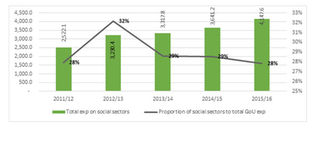When public expenditure misses its goals

A graph illustrates that from the FY 2012/13 to FY 2015/16, there was a decreasing total expenditure on social sectors in comparison to the total government expenditure.
Source: Author’s calculations and computations
What you need to know:
According to Uganda Bureau of Statistics, an individual is reported to be poor if they spend less than Shs29,505 per month. David Walakira delves into how some government programmes are failing to reduce poverty levels in Uganda.
The delivery of basic community services in a sufficient and equitable manner can be delivered through targeting interventions in the social sectors. Social sectors refer to education, health, social development, agriculture and water and environment.
Money spent in these sectors should have a ripple effect on reducing inequality among the social divides in the community. Inability of the marginalised and special interest groups to access basic services is shouldered by effective government expenditure.
Expenditure
Over the past five Financial Years (FY) beginning FY 2015/16 to FY 2011/12, Government has spent Shs16.8 trillion (29 per cent of its availed total resources) on these sectors.
The above graph further illustrates that from the FY 2012/13 to FY 2015/16, there was a decreasing total expenditure on social sectors in comparison to the total government expenditure. Taking poverty as social indicator to illustrate the ability of people to afford basic needs and ultimately their quality of life, its prevalence in between FY 2012/13 and FY 2016/17 increased from 19.7 per cent to 27 per cent, respectively. This translated into a 37 per cent increase in the number of people reported to be poor.
According to Uganda Bureau of Statistics (Ubos), an individual is reported to be poor if they spend less than Shs29,505 per month.
We can also observe that the expenditure on the social sectors between the FY 2012/13 and the FY 2015/16 was to a tune of Shs14.3 trillion, but the poverty numbers increased by 37 per cent. This means the expenditure on the social sectors in missing the intended goals, among others reducing poverty.
Programmes
Currently, programmes such as Social Assistance Grants for Empowerment (SAGE) running under the Social Development Sector, aimed at providing basic facilitation for the elderly on Uganda provides a monthly stipend of Shs25,000 which is below the poverty line and as such this expenditure, even when incurred by the government does not not work to reduce the number of Ugandans in poverty, but arguably to maintain them there.
Poverty and education sector
The same illustration pulled to the Education sector, indicated that the Shs10,000 provided by the government to educate a Ugandan child only serves to forge a path to eternal poverty.
According to the FY 2016/17 Household (HH) survey by Ubos, the average HH expenditure on school fees in rural areas is Shs190,000.
To illustrate the linkage between poverty and the education, the FY 2016/17 HH survey revealed that there is a 35 per cent chance that a Ugandan will be poor if they got some bit of primary education and 43 per cent chance if they don’t get any sort of education.
The report also reveals that in terms of education and development, respondents outside the Central region voiced their inability to afford school fees; school aged children also did not have access to a desk and chair to do their homework and age appropriate books. This finding is particularly worrisome in view of the decentralised nature of the national education system and the continued meagre government expenditure in the sector.
In West Nile, irrespective of the government expenditure on health, four out of five children are deprived of their right to health but also as a national average, one out of four respondents cannot afford health facility visits or purchase medication when their children are ill. To these findings in perspective, government spent Shs3.8218 trillion in the health sector between FY 2012/13 and FY 2015/16.
Possible solutions
In a nutshell, when it comes to the public expenditure to reduced inequality and poverty, there are prerequisites that cannot be ignored.
One of these prerequisites is in an efficient and effective system that can track the allocated and released funds, not only in the social sectors but also the economy.
Secondly, sanctions for misuse of public resources need to be clear and easy to invoke in the event of confirmed mischief. There also needs to be a deliberate effort for government to design programmes that do not negate national standards but also economic realities (considering the SAGE programme that gives funds below the poverty line and the UPE programme that offers Shs10,000 to educate a Ugandan child against the market reality of Shs190,000).
For the start, these conditions can propel us into discussing other conditions to ensure that public resources that are released to deal with poverty and inequality achieve the intended goals.
The writer is a budget policy specialist.




